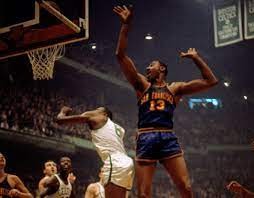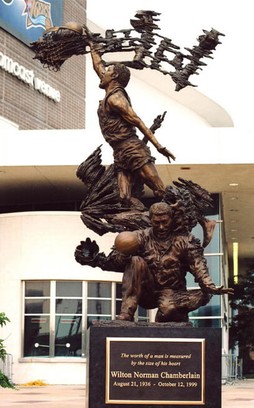Wilt Chamberlain Statue, Wells Fargo Center
Introduction
Text-to-speech Audio
Wilt Chamberlain's memorial statue was originally built and unveiled on June 28, 2004, in front of the Wachovia Center in Philadelphia, which is now known as the Wells Fargo Center. The statue was created to honor Chamberlain's legendary basketball career, but also for his life of support on behalf of a variety of organizations that were important to the people of Philadelphia. Chamberlain also supported important social causes, including his work to challenge segregation at several establishments during his college and early professional days.
Images
Wilt recording 55 rebounds vs the Boston Celtics

Wilt Chamberlain Statue outside the Wells Fargo Center

Backstory and Context
Text-to-speech Audio
Wilt Chamberlain played in the NBA from 1959-73, serving as the center for the Philadelphia Warriors (now Golden State Warriors), the Philadelphia 76ers, and the Los Angeles Lakers. Chamberlain is known for his offensive prowess, once scoring 100 points in a single game. He is also known for his rivalry with Bill Russell and the Boston Celtics, one of several NBA rivalries that helped to define an era of NBA basketball.
After a college career that included challenging segregation in Lawrence, Wilt was drafted by the Philadelphia (San Francisco) Warriors. Thanks in part to his successful rookie season, the team made it to the conference finals against the Boston Celtics, and that is where the rivalry of Wilt Chamberlain vs. Bill Russell in playoff matches was born. Russell's team beat Chamberlain's teams eight times while Chamberlain's teams prevailed twice. After many years of an early exit in the playoffs, in the 1966-67 season, Chamberlain finally won his first title with the Philadelphia 76ers.
Wilt Chamberlain broke many records during his time as an NBA player, but his most memorable one is his 50.4 PPG (Points Per Game) average in the 1961-62 regular season. He also averaged 48.5 minutes per game which meant he rarely left the floor that season.
After his NBA career, Wilt spent one year as an ABA player-coach for the San Diego Conquistadors. He also played and managed for a short-lived professional volleyball league and was inducted into the Volleyball Hall of Fame. In 1992, the man known as "Wilt the Stilt" and "The Big Dipper" was hospitalized for an irregular heartbeat, an ailment that plagued him for many of his final years. Chamberlain passed away in 1999 at the age of 63.
Sources
Source 1: Basketball Reference. Accessed May 20th 2021. https://www.basketball-reference.com/players/c/chambwi01.html.
Source 2: Legends Profile NBA.com. Accessed May 20th 2021. https://www.nba.com/history/legends/profiles/wilt-chamberlain.
Source 3: Wilt Chamberlain Archive, Youtube. Accessed May 20th 2021. https://www.youtube.com/c/WiltChamberlainArchive/videos.
Google Images and NBA.com
